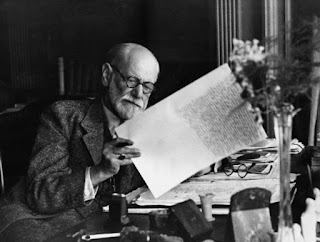What is
psychoanalysis?
The development
of psychoanalysis has its origin in the medical practice of Sigmund Freud in
Vienna around 1900.
Freud,
who is considered as the founder of psychoanalysis, was an
Austrian neurologist. He was born to Galician Jewish parents on 6th
May 1856. In the year 1938, Freud left his native country (Austria) in order to
escape his life from the Nazis. The very next year (that is 1939), he died in
exile in the United Kingdom on 23rd September 1939.
Freud
was a practicing physician who specialized in diseases of the nervous system.
He found that many of his patients with nervous disease were indeed suffering
from mental conflicts and neurotic states. These mental conflicts and neurotic
states manifested themselves as physical disorders such as extreme fatigue,
nervousness, insomnia, and so on.
In such
a situation, treating the patients’ physical symptoms failed to get at the root
of the problem. Clearly, what the patients needed was psycho-therapy rather
than physical therapy.
While
Freud was puzzling over these difficulties, Jean-Martin Charcot, a French
practitioner, and Joseph Bewer, a German practitioner had been experiencing
considerable success with the “hypnotic treatment” of hysteria. Freud was in
touch with these results.
Sigmund
Freud tried out hypnotic treatment on his patients. Soon, he noticed that all
patients could not be hypnotized. Moreover, hypnosis resulted only in a
temporary alleviation of symptoms, not in permanent cure.
Freud observed that the real value of this
treatment lay in a deeper and more complicated analysis of the patients. Thus,
he changed over to a new technique called the “free association technique”.
Free
Association Technique:
In “free
association technique”, the patient relaxes on a couch and freely tells
whatever comes into his mind. The psychoanalyst listens to the patient and
observes his emotional reaction, signs of distress, resistance to the treatment
and so on.
Following
this session, the therapist discusses with the patient interpretation of the
facts which had been brought to light during the analytical period.
Dream
Analysis:
During the
course of his practice, Freud became convinced that dreams were of special
significance for the new therapy. The analysis of the dream revealed to him the
hidden wishes, lost memories, and emotional attitude of the patient.
Dream analysis,
or the analysis of a patient’s dream, also revealed repressed unconscious
desires which were very important for the treatment of neurotic disorders. Freud
considered dream interpretation as an important part of the theory and practice
of psychoanalysis. He considered dream as a royal road to the interpretation of
unconscious.
After
the analysis, dreams reveal two distinct types of contents—the manifest content and the latent content.
The dream
as remembered by the dreamer upon awakening is the manifest content. But the
real or the hidden facts in the dream are the latent contents of the dream.
The latent
content may be quite different from the manifest content, because the former
gets distorted and undergoes considerable modification by a certain process
known as “dream work”.
Dream
work operates through three ways: condensation, displacement, and secondary
elaboration.
Condensation: In
condensation, some elements of the dream are omitted altogether and others
appear only in a fragmentary form. Sometimes, several elements may be blended
into one. Generally unpleasant, unacceptable and harmful events in the dream
are condensed.
Displacement: Most
often, some elements of the dream may be replaced or displaced by other
elements which are acceptable to the dreamer. Sometimes, the latent content of
the dream takes an opposite direction. For example, clothing often represents
nakedness; love may be a disguise for hate. This process is known as displacement.
Secondary elaboration: It is
a process of hiding the real significance of the dream. Through this process,
the dreamer, upon awakening, makes a good story out of the dream. He,
therefore, adds new elements that were not in the original dream.
Dream
analysis is designed to reverse these various processes and to reveal precisely
what is repressed or hidden. This is done in two ways: First, the dreamer is
required to associate around the various elements of the dream. Second, the
dreams generally appear symbolically. Thus, an analysis of the various symbols
in the dream reveals the real object of the dream.




